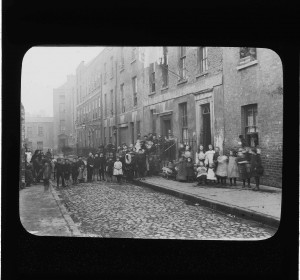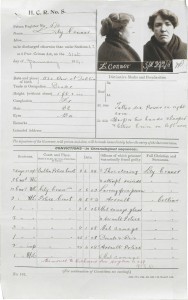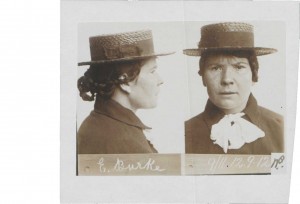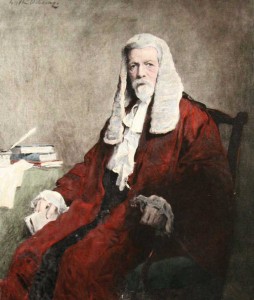Inebriate women in early twentieth-century Ireland
Published in 20th Century Social Perspectives, Features, Issue 6 (November/December 2014), Volume 22
Chancery Lane, off Bride Street, c. 1913—typical of the streets from which many of the inebriate mothers detained at the State Inebriate Reformatory, Ennis,
originated. (RSAI)
On 14 November 1901 Elvina T. appeared before the Dublin City sessions charged with child neglect and with being a habitual drunkard. The previous month, a Society for the Prevention of Cruelty to Children (SPCC) inspector had visited her family home at Kevin Street to find the children ‘miserably clad’. Some weeks later he found her in a drunken state in a room in Longford Street. The room was described as filthy and rodent-infested; one of her children had had its face and hands ‘gnawed’ by rats. The Recorder of Dublin, Sir Frederick Falkiner, described the case as ‘one of the most shocking that had ever come before him’. Elvina was sentenced to eighteen months at the State Inebriate Reformatory.
In the spring of 1901 the Irish Independent described how Ireland was ‘leading the way in the lately-legislated movement for vesting in the state the control of chronic drunkards’. The State Inebriate Reformatory opened in June 1900 at a disused gaol in Ennis, Co. Clare, for the purposes of punishing and reforming habitual drunkards who were found guilty of an alcohol-related criminal act. The reformatory was managed by the General Prisons Board as part of the penal system and operated in Ennis until 1918, when it was transferred to Cork prison; it closed two years later.
Drunken violence in a ‘Christian country’Violence was often a factor in the behaviour of drunken mothers, typically directed at the husband and children. Anne C., aged 44, appeared before the Recorder’s Court in Dublin in January 1904 and was tried on three charges of cruelty to children as well as being a habitual drunkard. Anne was married and the mother of five children, two of whom were deceased. Her children were aged thirteen, eight and three. Her husband, a shoemaker, claimed that his wife had made his life ‘intoler-able’. He believed that his work and his life were in danger after she destroyed the tools of his shoemaking trade and poured paraffin oil on his head. She repeatedly pawned her children’s clothes, while her ‘own clothing was no sooner on her back than they were in the pawn-office’. Anne regularly neglected her family by staying outdoors all night, as well as all day one Christmas. An SPCC inspector found that she was wholly unfit to care for her children and that her continued presence in the house put them in physical danger and was likely to cause them ‘un-necessary suffering’. It was alleged that during episodes of drunken violence Anne threw boots at her children. Significantly, the inspector claimed that they no longer wanted her in the home. In passing a sentence of two years at Ennis reformatory on Anne, the Recorder, Sir Frederick Falkiner, commented that ‘it was dreadful to have such pictures of home life in a Christian country like this’.

Esther Burke, a charwoman, aged 33 on admission to the State Inebriate Reformatory at Ennis in March 1911, received an eighteen-month sentence for assault and being a habitual drunkard. Born in Finglas, she was married with two children (three others deceased) and had 43 previous convictions. (NAI)
By the end of the first decade of the twentieth century, women were increasingly turning to porter as their alcoholic drink of choice. This was particularly offensive to sentencing judges, as evidenced in the case of Teresa P., a 45-year-old mother of eight. Teresa first appeared before the Recorder of Dublin at the City sessions on 17 May 1909, when she was convicted of neglecting her children and of being a habitual drunkard. Two witnesses from the SPCC testified against Teresa; they described what they saw as a constant addiction to alcohol, and one that made her unable to take care of her children. Her youngest child was just six months old. Her husband James, a labourer, was also questioned and he admitted that his wife’s behaviour was not at all problematic when she was sober, which was seldom. Upon hearing that Teresa’s drink of choice was porter, the Recorder expressed his disgust at the consumption of this particular substance, which he declared ‘produces a drunkenness of a loathsome character especially amongst women’. Crime in Dublin, he continued, was mostly the product of environment, and he drew attention to the ‘shocking condition’ of housing for the poor. He concluded that ‘it is all very well for the better class but housing, drink and crime have really become practically interchangeable terms’.

Lily Connor, a fish-dealer, aged 31 on admission to the State Inebriate Reformatory at Ennis in February 1911, received a three-year sentence for attempted suicide and being a habitual drunkard. Born in Dublin, she was married with no children and had 55 previous convictions. (NAI)
Teresa admitted to the crimes with which she was charged; she was found guilty accordingly and sentenced to eighteen months in Ennis. She was discharged on 4 January 1911, but on 24 June of the same year she was charged with aggravated assault on her husband the previous evening. She was detained at Lad Lane RIC station in Dublin. During the assault she bit the forefinger of his right hand, causing an injury so severe that he required surgical treatment at the Meath Hospital. The incident arose after James arrived home from work to find Teresa drunk and threatening to assault their thirteen-year-old daughter, Mary. It was during his struggle to prevent the assault that she attacked her husband. He reported that since her release in January his wife had repeatedly turned to liquor, which in turn caused her to become violent. On 17 July 1911 she was sentenced to twelve months’ detention at the certified inebriate reformatory in Wexford. An aftercare report provided the first hint that there might be a problem with Teresa’s husband. ‘I am of the opinion’, wrote an agent, ‘if she had a kind husband and family she would not be in the Wexford reformatory.’ Spousal abuse was often an underlying theme in the case of drunken and neglectful mothers, although this was not taken into account in court to any large extent.
‘And the prisoner was drunk and violent’
The death of a child as a result of parental ill treatment was almost unheard of among the Ennis inebriates. Bridget M., aged 31, appeared before the Recorder of Dublin on 6 October 1909, charged with ill-treating and neglecting her children and with being a habitual drunkard. Bridget was married with four children, aged between eleven years and eighteen months, with one deceased; the family lived in a Corporation building in Mabbot Street. Prior to her conviction, Bridget spent an increasing amount of her time in public houses ‘consorting with prostitutes’. It was her husband who sought the assistance of the SPCC. An inspector visited the house on 21 June and found the children ‘in a very bad state from neglect’. He testified that her behaviour towards her children was not in question when she was sober. Dr Powell, also of the SPCC, later found that ‘they bore appearances of having been thoroughly neglected’; he advised their admission to the workhouse hospital. The youngest child, George, was in such a weakened state that he was unable to digest his food. According to the doctor, he weighed eleven pounds when the natural weight for an infant of that age would have been between sixteen and eighteen pounds. He eventually died. The Recorder described Bridget’s case as one of the worst he had ever tried and sentenced her to two years in Ennis.
Forty-two-year-old Mary S., married with six children, appeared before Judge Wright at Dublin City Commission on 6 August 1902, charged with neglecting her children and being a habitual drunkard. The family lived in Meath Street. On 23 May 1902 an SPCC inspector visited the family home, where one of the children, nine-year-old Teresa, claimed that her mother had beaten her when she refused to go and purchase alcohol. The child denied her mother’s claim that it was her father John who sought the drink. On 8 July the inspector returned to the house to find ‘the children almost naked, and the prisoner drunk and violent’. John alleged that Mary often became violent towards her family, pulling the children by the hair as well as beating them and her husband. Mary’s second eldest daughter told the court that she earned eight shillings per week, which she gave to her mother, but since the police prosecution she gave it to her father. Her mother did not interfere with her to any great extent except to pawn her bed. It appears that the court and the SPCC were most concerned with the younger children, although the evidence of the older girl was instrumental in securing Mary’s conviction for child neglect with the added-on charge of being a habitual drunkard. Mary was sentenced to two years at Ennis inebriate reformatory. She was discharged from Ennis in August 1904, having served her full sentence. By April 1907 Mary was serving three months in Mountjoy prison for drunkenness and assaulting her husband. By late 1909, after a brief period of sobriety, she was again drinking heavily and was described as ‘abusive’ towards her husband and ‘quarrelsome’ with her family. Mary died on 6 January 1911. She was one of many discharged Ennis in-ebriates, male and female, who would die at a young age.
The women who ended up in the Irish State Inebriate Reformatory were an affront to early twentieth-century societal norms, which saw Irish mothers as good housekeepers, moral, tidy and clean. This was never more obvious than when a woman took her drunkenness out of the private sphere of the household and into the pub or the street. The courts had little hesitation in punishing mothers and imposing harsh sentences regardless of the context, which could include the pressure of high birth rates and the unsupported grief of high child mortality rates. Certain mothers remained in a state of economic powerlessness and this only served to heighten the misery when addiction was involved. During sentencing, almost no account was taken by the courts of the impoverished condition in which mothers, mainly slum-dwellers, were forced to raise children. While judges often expressed their outrage and offence at the state of housing (in Dublin in particular), it did not stop them from further burdening families by removing the mother for a period of years.
Conor Reidy is the author of Ireland’s ‘moral hospital’: the Irish Borstal system, 1906–1956 (Irish Academic Press, 2009).
Read More:1898 Inebriate Act
Certified Reformatories
Further reading
S. Buckley, The cruelty man: child welfare, the NSPCC and the state in Ireland 1886–1956 (Manchester, 2013).
C. Clear, Social change and everyday life in Ireland, 1850–1922 (Manchester, 2007).
D. Ferriter, Occasions of sin: sex and society in modern Ireland (London, 2009).
C. Quinlan, Inside: Ireland’s women’s prisons, past and present (Dublin, 2011).

















